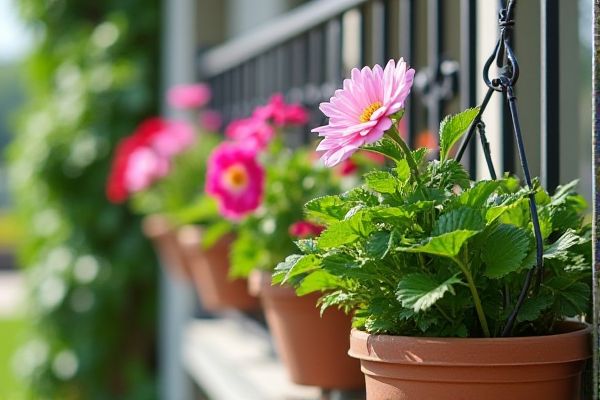
Railing planters provide sturdy, space-saving solutions by securely attaching to balcony or deck railings, offering better stability and often more room for soil and plant roots compared to hanging baskets. Discover how choosing between railing planters and hanging baskets can enhance your gardening space and fit your lifestyle by reading the rest of the article.
Table of Comparison
| Feature | Railing Planters | Hanging Baskets |
|---|---|---|
| Installation | Mounted on railings, secured with brackets | Suspended from hooks or ceiling mounts |
| Space Usage | Utilizes balcony or deck rails, saves floor space | Utilizes overhead space, ideal for small areas |
| Plant Type | Suitable for trailing and upright plants | Ideal for trailing plants and flowers |
| Water Drainage | Usually with drainage holes; excess water drains easily | Good drainage but requires drip trays or mat |
| Aesthetic | Provides structured and linear look | Creates a hanging garden effect, more decorative |
| Maintenance | Easy to access for watering and pruning | May require ladder or step stool for care |
| Weight Capacity | Supports medium weight plants | Depends on hook and ceiling strength, usually lighter plants |
| Best Use | Balconies, decks with railings | Porches, patios, spaces without railings |
Introduction to Railing Planters and Hanging Baskets
Railing planters and hanging baskets offer versatile solutions for adding greenery to limited spaces, each designed to maximize vertical gardening potential. Railing planters securely attach to balcony or deck railings, providing stability and easy access for care, while hanging baskets suspend plants in the air, creating dynamic visual appeal without occupying floor space. Both options enhance outdoor areas by optimizing space usage and allowing a variety of plant selections, from flowers to herbs.
Design and Aesthetic Appeal
Railing planters offer a structured, linear design that enhances balconies and decks by framing outdoor spaces with vibrant greenery. Hanging baskets contribute a more dynamic and layered visual effect, allowing plants to cascade naturally for a softer, more whimsical aesthetic. Both options provide versatile ways to display flowers and foliage, but railing planters emphasize order and symmetry, while hanging baskets focus on movement and depth.
Space Efficiency and Placement Options
Railing planters maximize vertical space by securely attaching to balcony or deck rails, ideal for small areas where floor space is limited. Hanging baskets offer flexible placement, allowing plants to be suspended from ceilings or hooks, freeing up both floor and railing surfaces. Both solutions optimize space differently, with railing planters providing sturdy support along borders and hanging baskets enabling elevated display options.
Installation and Mounting Process
Railing planters offer straightforward installation by securely clamping onto balcony or deck railings with adjustable brackets, ensuring stability without the need for additional hardware. Hanging baskets require ceiling hooks or sturdy overhead beams for mounting, which may involve drilling and anchors, making them slightly more complex to install. Your choice depends on ease of installation and available mounting points, with railing planters typically providing quicker setup and minimal structural impact.
Plant Variety Suitability
Railing planters are ideal for growing a wide variety of plants, including herbs, flowers, and small vegetables, thanks to their sturdy structure and ample soil depth providing better root support. Hanging baskets are better suited for trailing or cascading plants such as petunias, fuchsias, and ivy, which can visually spill over the edges and benefit from good air circulation. Choosing between railing planters and hanging baskets depends on your desired plant types and the growing conditions each container can offer.
Watering and Drainage Considerations
Railing planters typically offer better drainage options with built-in holes and trays, helping prevent waterlogging and root rot, whereas hanging baskets often require more frequent watering due to faster drying caused by air circulation. Your choice depends on how accessible the plants are for regular watering and the specific moisture needs of your chosen greenery. Proper watering schedules and ensuring adequate drainage are crucial for healthy growth in both railing planters and hanging baskets.
Durability and Maintenance
Railing planters offer superior durability due to their sturdy materials like metal or thick plastic, making them resistant to wind and weather conditions compared to the more fragile hanging baskets often made of woven or lightweight materials. Maintenance for railing planters is generally easier, as they provide stable soil conditions and less risk of water dripping onto your deck or porch, while hanging baskets require frequent watering and careful drainage management to prevent plant stress. Choosing railing planters can reduce your upkeep time and provide longer-lasting support for your plants in outdoor environments.
Cost Comparison
Railing planters generally offer a more cost-effective option as they are reusable, durable, and reduce the need for frequent replacements compared to hanging baskets. Hanging baskets often incur higher initial costs due to specialized hardware and may require more frequent plant replacements because of exposure to harsher conditions. Budget-conscious gardeners typically find railing planters provide better long-term value with lower maintenance expenses.
Environmental Impact
Railing planters generally offer a more sustainable option by reducing soil runoff and water waste compared to hanging baskets, which often require more frequent watering due to faster drying. The materials used for railing planters, such as recycled metals or biodegradable composites, tend to have a lower carbon footprint than plastic hanging baskets commonly found on the market. Choosing railing planters supports environmental conservation by promoting efficient resource use and minimizing waste in your gardening practices.
Best Uses and Recommendations
Railing planters offer sturdy support for growing herbs, flowers, and vegetables along balconies or decks, making them ideal for maximizing limited space while ensuring stability against wind. Hanging baskets excel in adding vertical interest with trailing plants like petunias or ferns, perfect for brightening porches or shaded patios without occupying floor or railing space. For best results, choose railing planters when safety and durability are priorities, and opt for hanging baskets to create layered, dynamic garden displays in compact outdoor areas.
 homyna.com
homyna.com